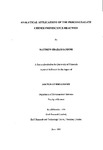ANALYTICAL APPLICATIONS OF THE PEROXYOXALATE CHEMILUMINESCENCE REACTION
| dc.contributor.author | SANDERS, MATTHEW GRAHAM | |
| dc.contributor.other | School of Geography, Earth and Environmental Sciences | en_US |
| dc.date.accessioned | 2013-09-18T10:11:55Z | |
| dc.date.available | 2013-09-18T10:11:55Z | |
| dc.date.issued | 1999 | |
| dc.identifier | NOT AVAILABLE | en_US |
| dc.identifier.uri | http://hdl.handle.net/10026.1/1832 | |
| dc.description.abstract |
The overall objectives of this thesis were to investigate the potential of the peroxyoxalate chemiluminescence (POOL) reaction for the quantitative detection of target analytes in non-aqueous matrices and to compare quantitative performance with fluorescence detection. The target analytes investigated were polycyclic aromatic hydrocarbons (PAHs) and aliphatic amines. These were selected as an important class of compounds in engine exhaust emissions and a detergent additive in diesel fuel respectively. Chapter one outlines the challenges of analysing petroleum products and engine exhaust emissions and discusses the potential of luminescence techniques, particularly chemiluminescence (CL), for the quantification of trace components. The chapter also reviews the technique of flow injection (FT) as a means of sample delivery for CL detection and as a potential technique for field deployment. Liquid chromatography techniques are described as a means of separation of complex matrices, e.g. fuels and engine exhaust particulates, in the laboratory prior to CL detection. The luminescence properties of several PAHs were investigated in Chapter Two. Optimum excitation and emission wavelengths for eleven PAHs in four different solvents were determined using a batch fluorescence technique. A FI approach was used to determine PAH concentrations using fluorescence and POCL detection. Two aryl oxalates; bis(2,4-dinitophenyl)oxalate and bis(2,4,6-trichlorophenyl)oxalate were compared for their suitability for PAH determinations and an investigation of the key variables (e.g. concentration of aryl oxalate and hydrogen peroxide, mobile phase composition and pH) affecting POCL was performed. Recommendations for the optimum conditions for the determination of PAHs by POCL detection were determined, A comparison between a photodiode based detection device and a low power (12V) photomultiplier tube was also described. In Chapter Three the procedure of using POCL detection as a post column liquid chromatography (LC) detector for PAHs has been considered. The performance of the POCL detection system was compared with wavelength programmed fluorescence. Both reversed and normal phase LC was investigated and the suitability of POCL detection with each approach was discussed. Additionally the procedure for the LC separation and analysis of SRM 1649 (Urban Dust/Organics) and SRM 1650 (Diesel Particulate Matter) was described. The relative performance of fluorescence and CL detection are discussed. Chapter four describes the principles of multivariate calibration of spectrophotometric data, and three commonly applied techniques (PCR, PLSI and PLS2). Fluorescence data was obtained for synthetic mixtures of PAHs containing two, three, four and five components. A procedure whereby individual spectra were 'glued' together before undergoing data analysis has been developed and the results obtained discussed. POCL emission spectra for five PAHs were acquired using a two-dimensional charge coupled device (CCD). The sensitivity of the CCD system toward POCL detection of PAHs and a multivariate investigation using benzo[a]pyrene and benzo[k]fluoranthene has been described. The potential of the fluorescence and CL approaches used has been discussed. Chapter five describes the aryl oxalate sulphorhodamine-101 CL reaction and its application to the determination of amines. A FI optimisation of the reaction parameters is presented together with some quantitative data for the detection of a homologous series of amines and dodecylamine (a commonly added detergent compound in diesel fuels). The application of the technique toward the detection of dodecylamine in a diesel fuel matrix and the potential as a field deployable technique was also considered. | en_US |
| dc.description.sponsorship | Shell Research Limited, Shell Research and Technology Centre, Thornton, Chester | en_US |
| dc.language.iso | en | en_US |
| dc.publisher | University of Plymouth | en_US |
| dc.title | ANALYTICAL APPLICATIONS OF THE PEROXYOXALATE CHEMILUMINESCENCE REACTION | en_US |
| dc.type | Thesis | |
| plymouth.version | Full version | en_US |
| dc.identifier.doi | http://dx.doi.org/10.24382/1585 | |
| dc.identifier.doi | http://dx.doi.org/10.24382/1585 |
Files in this item
This item appears in the following Collection(s)
-
01 Research Theses Main Collection
Research Theses Main


